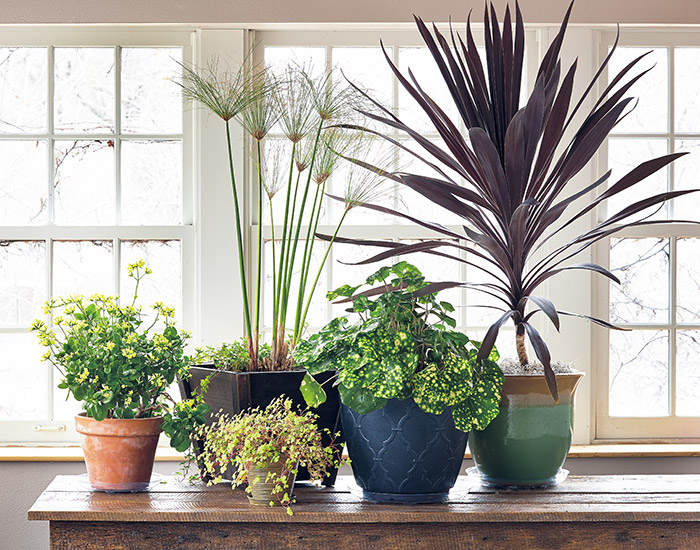Don’t throw out tender plants at the end of the season! Save your container plants for next year by bringing a few favorites indoors as houseplants.

Save your container plants indoors over the winter
At the end of the season it’s hard to say goodbye to the plants that have done so well in containers — especially the out-of-the-ordinary ones. The good news is many of them can dress up the living room just as well. Let me walk you through how to save your container plants indoors over the winter so you can grow them outdoors again in spring.
1. Prep plants for the indoors
When nighttime temperatures are around 40 to 45 degrees F, bring tender plants inside for the winter. You may want to repot them into lightweight nursery pots beforehand so they’re easier to transport and slip into a “dressier” pot indoors.
Rinse thoroughly, both upper and lower leaf surfaces, with the hose or a damp cloth to wash off any pests that might be hitchhiking. Moving them inside at night and out again during the day over several days, gradually increasing the amount of time they’re indoors, will help them acclimate.
2. Find the right spot in your house
Set the plants next to a sunny south-facing window and out of the direct line of heat vents — dry, warm air dries out foliage and potting mix. Temperatures between 68 and 75 degrees F during the day and 6 to 8 degrees cooler at night are best for most plants. The shorter days and less intense light will cause slower growth so there’s no need to feed them.
3. Slowly acclimate the plants outdoors in spring
In spring, when the risk of frost has passed and daytime temperatures are 60 to 65 degrees F, your indoor plants can go outside again. To harden off plants off, move them in stages to avoid foliage burn from too much sun all at once. Start plants out in the shade for a few hours each day and work up to full sun, if needed.
How to overwinter 3 popular container plants indoors
Kalanchoe (Kalanchoe blossfeldiana)
Shorter days in fall encourage this succulent to form flower buds — the one here bloomed by February. Because it’s actively growing this time of year, include a liquid house plant food once a month but wait to water until the potting mix is dry. By spring an overwintered plant can get leggy. Cut it back by a third for a bushier plant.
Though it stops blooming by summer, kalanchoe’s broad leaves are a great texture contrast with other succulents outdoors.

Oxalis (Oxalis spiralis vulcanicola)
Oxalis is undemanding but does best with consistent moisture. Colorful or variegated leaves may fade, as this one has, but once the days get longer the new growth will be back to normal.
The foliage on this oxalis is starting to look a bit leggy in the photo. If your oxalis gets bedraggled you can cut it back by a third and it will rebloom. Or you can cut it back to the crown and let it go dormant. Don’t water and give it some time. With plenty of light in spring your oxalis will take off — once you see new growth start watering again.

Dracaena palm (Cordyline australis)
With its big strappy foliage, dracaena palm is great for adding a tropical look to your plantings. It’s a fast grower and while cold-hardy in USDA zones 8 or 9 to 11, it makes a great house plant, too.
Dracaena palms like consistent moisture during the growing season but you can let the potting mix dry out between drinks indoors. To dress up its bare trunk and conserve moisture a bit, add a layer of sphagnum moss. No need to feed or mist for humidity, though you may want to wipe off the broad leaves if they look dusty to help them absorb light better.
By Jennifer Howell | October 22, 2019

Leave a comment